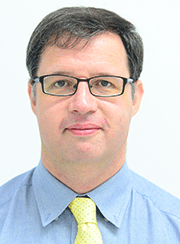E-Archive
Newsbeat
NEWSBEAT – Conversations with Rosanne Baiker
in Vol. 16 - November Issue - Year 2015
ARTC Combines The Challenging Industrial Requirements With The Creation Of Industrial Solutions For Manufacturing And Remanufacturing

David Butler, Business Development Director of the ARTC
MFN had the opportunity to talk to David Butler, Business Development Director of the Advanced Remanufacturing & Technology Centre.
ARTC is still a very new platform. Would you explain to our readers what ARTC stands for and what its concept is?
The Advanced Remanufacturing & Technology Centre (ARTC) is a new initiative under A*STAR in partnership with the Nanyang Technological University (NTU). ARTC is based in Singapore and is Asia's first centre for test bedding and developing remanufacturing technologies, and focuses on developing industry-ready solutions for its members.
The centre operates under an industry-led private-public partnership model, and currently boasts 29 member companies. It creates a collaborative environment where companies can leverage off each other as well as the resources of the centre. In the context of technology readiness levels (TRLs) where 1 is fundamental research and 9 is a successful deployment/production of the technology, the ARTC focuses on the middle ground (TRLs 4 to 7) where the concepts are transferred from the research lab, scaled-up and demonstrated in an operational environment. It is this translation from the research environment to industry where many technologies fail and is known by many as "the valley of death". By involving end users, equipment and service providers as well as ARTC's capabilities, we have been able to successfully traverse the valley and implement new technology into our members' factories. We hope to become a catalyst within the manufacturing and remanufacturing industry, by creating solutions for both international MNCs as well as SMEs, and help them generate new business opportunities.
Is there a focus on certain technologies and applications?
The centre focuses on four technology themes; repair & restoration, surface enhancement, product verification, and additive manufacturing. Examples of the technologies we are involved include: robotised finishing of components, part life extension using shot peening and low plasticity burnishing, industrialisation of additive manufacturing of metallic components, laser metal deposition for repair and process condition monitoring.
ARTC has a strong partnership with Nanyang Technological University. Could you give us some details of the nature of this partnership?
The Nanyang Technological University (NTU) is located about 300 metres from the ARTC and is one of the leading global technology universities. A key objective of the ARTC and NTU's partnership is to create and nurture talent. The partnership encompasses a number of engagement activities including fundamental and applied research and manpower development. Currently there are 12 PhD students and 10 faculty members who are working with the centre on projects. Typically, the basic research is undertaken by the faculty and students, for example, the modelling of the severe shot peening process, robotic force control and material defect characterisation. The PhD students are encouraged to apply their fundamental knowledge to real industrial challenges in the latter years of their study. In addition, the centre also takes masters and undergraduate students for both projects and internships - this has paid off in that five members of staff were originally attached to the centre as students.
What kind of feedback does your organisation receive from the industries and where would you see ARTC five years from now?
For a centre operating in this environment, industrial feedback is keenly sought and acted upon. An example would be our activities in additive manufacturing, which was proposed by several industrial members who successfully lobbied the government to establish this activity. It differs from other additive manufacturing facilities in that our members wanted a clear focus on the industrialisation of additive manufacturing with the intention to produce and verify real components over the next few years. In five years' time, I would envisage a membership base of around 60 companies covering a wider spectrum of industries including transportation, clean energy and oil & gas. While the current focus is on process development, there is a need to provide additional services to companies such as developing the value proposition for companies to undertake remanufacturing - we are already receiving enquiries from companies who would like to get involved in remanufacturing but are not clear where to begin.
What are your responsibilities in ARTC and in what projects are you involved?
My role in the ARTC is primarily as Business Development Director leading a team in developing industrial partnerships with members as well as recruiting new member companies. As a NTU Associate Professor, I also run a team of researchers in the area of surface metrology and shot peening with the students based in the ARTC working on surface defect detection and severe shot peening.
MFN would like to thank David Butler for the interview!
For Information:
Advanced Remanufacturing and
Technology Centre (ARTC)
3 CleanTech Loop, #01/0
CleanTech Two, Singapore 637143
Tel. +65.6908.7900
E-mail: david-butler@artc.a-star.edu.sg
www.a-star.edu.sg/artc



























